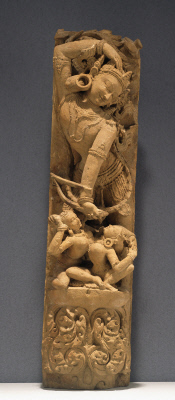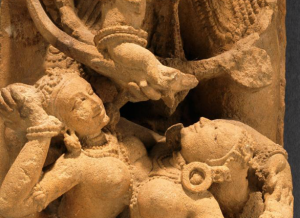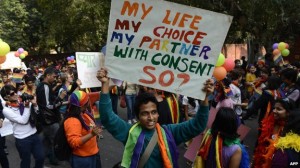Many of the major religions that have been largely active and influential in the world have heteronormativity and heterosexism as written and working inner parts. Hinduism cannot be fully be included, though within its myths and literature such social constructions are found; these are far from the sole beliefs. Other, equally legitimate religious writings and images make it stand out as also being accepting of LGBT+ identities. A Shaiva priest sums his conclusion of what the Hindu scriptures express about same-sex marriage is that “marriage is the union of spirits, and the spirit is not male or female” (Vanita, 56). This is made possible by the fact that Hinduism has consistently functioned on a myriad of different and coexisting beliefs, with local cultures and individual people interpreting texts to suit them. This makes it so that same-sex love and relationships, as well as marriage, are legitimate within Hinduism, despite the current ruling party, the BJP’s, contrary beliefs.
There is a large portion of Hindus who see one’s life as having four goals, success (atha), social righteousness (dharma), pleasure (kāma), and renouncement (mokṣa) (Doniger, 2005). While pleasure isn’t held in as high of a light as the other goals, it is seen as necessary, especially as it pertains to reproduction. It is also not just seen as pleasure but passion and love. “Kāmasūtra,” a guide addressing the kāma goal, includes non-heterosexual sexual acts (Hiltebeitel, 2005; Anderson, 2005). Written works that lay out laws also take homosexual acts into account. “Arthaśastra” is one such piece, and while it lays out punishment for both sexual acts between two men and those between two women, the latter is seen as meriting a lesser fine (Anderson, 2005). Within the 11th century stories of the “Kathasaritagara” same-sex male attraction is dealt with. It is explained as something left over from a previous life, such as the individuals were different sex lovers before (Vanita, 55).
Writing is not the only way in which LGBT+ identities have been expressed in Hinduism, images also play their part in informing culture. A carving given the title “Kama, God of Love” shows that the god’s passion/love arrow pointed at a couple, consisting of two women, sitting at his feet. As you can see, while the women’s hands are clasped above their heads, they are seated intimately close, their faces are alight with happiness, and Kama is smiling benevolently down upon them. All this implies they are much more than onlookers of a god’s deed, but that they instead a couple receiving the benefit of said act. This is just one image, there are also more explicate ones found on surviving Khajuraho temples depicting homosexual acts. These temples are covered in carvings of all acts of life, because the culture from which they originate believed in dealing with such things frankly (World Heritage). As other Khajuraho temples have been destroyed, it is unknown what they might have depicted, but those that remain suggest that during the time homosexuality was considered just another part of life.
It is hard to know exactly what pre-colonial views were on the existence of LGBT+ people and acts. The text and images mentioned above suggest they were an acknowledged part of society. It is equally hard to know what was destroyed, hidden, wrongly translated, or stolen by the occupying British government who came from a much more outwardly homophobic culture. Ruth Vanita in her paper “Same-Sex Weddings, Hindu Traditions and Modern India” examines this, as well as how lower-income families respond to their daughters marrying other women. Vanita finds that parents’ issues with their daughter’s marriages is less due to them being same-sex and more because they are love unions instead of arranged (49). There is near equal stigma for different sex love unions, but it is just that same-sex unions are always chosen by love and not parents. The range of acceptance by families of their daughter’s choices range from adapting and accepting to rejecting, usually causing the involvement with the police, which can turn violent (Vanita, 49-50). If the women are separated they will usually be married to male suitors. Because they can’t be with the partners they love and chose, female couples may enact a double suicide. The fact that these Hindu women are marrying each other, many times with no contact to LGBT+ rights groups, shows how they believe their religion allows it (Vanita, 48). Added to this that some families come to accept these unions (Vanita, 51), it is interesting to think that the culture may shift to either be more welcoming of love marriages or incorporate same-sex preferences into arranged ones.
On the flip side, in October 2014 a man was arrested for Section 377, after his wife caught proof of him having sex with male partners (Qureshi, 2014). Section 377 has been the focus of LGBT+ rights groups due to its threat to their communities, who are afraid to be out because they worry that the police will be able to arrest them on this charge (Lalwani, 2009). It is a 153-year-old law instituted by British colonizers, and what Vanita labels an attack on India social morals (Vanita 48-49). The Supreme Court ruled that it is up to the parliament to decide whether this law stays in effect, but that they deem it to be unconstitutional (Qureshi, 2014).
The problems come when the law is involved, which goes back to political views and decisions. If it is the parliament that decides if laws like Section 377 stay in effect, it is problematic that the current party, the BJP, is on the political right and opposed to LGBT+ rights as they see them as unnatural and unsocial (Vanita, 50). When talking about why they oppose same-sex love, the BJP quote the Qu’ran and the Bible (Lalwani, 2009), and not Hindu scripture, which goes against the usual political rhetoric supported by the use of such scriptures as the epics (Cook, 2001). Modi’s election as prime minister has caused fear in the LGBT+ communities. He has remained rather silent on the issues since his election (Biwas, 2014), but his party has consistently been outspoken against such identities and marriages.
As in the rest of Hindu society, religious leaders hold many different views. Some religious leaders are happy to give the weddings to the same-sex female couples, while others side with the BJP that LGBT+ individuals and acts are unnatural. Many do not even agree with other’s within their linguae about validity, and this is because of the range of opinion within Hindu texts and local interpretation (Vanita 51-53, 56-58). It comes down to how they read texts and what texts they choose to believe are valid. Linda Hess in her article “Rejecting Sita” talks about how the popular character Sita, who is treated poorly by her husband, has now been left behind or radically changed by women, who want someone powerful to represent them (Hess, 1999). Like women with Sita, LGBT+ individuals and groups can create their own interpretations of existing Hindu texts about themselves, or to find themselves within the texts, thus reclaiming stories and characters.
From LGBT+ groups to the families of same-sex couples to religious leaders, people can find legitimacy within Hinduism for same-sex love, making Hinduism stand out among other major religions.
Work Cited
Vanita, Ruth. “Same-Sex Weddings, Hindu Traditions and Modern India.” Feminist Review.91 (2009): 47-60. ProQuest. Web. 5 Nov. 2014.
Ishikawa, Chiyo. “Kama, God of Love.” SAM. Seattle Art Museum, 2010. Web. 9 Oct. 2014.
Lalwani, Sheila B. “Coming out in force: the rise of the gay rights movement in India.” Kennedy School Review 9 (2009): 65+. General OneFile. Web. 22 Oct. 2014.
Anderson, Carol S. “Lesbianism.” Encyclopedia of Religion. Ed. Lindsay Jones. 2nd ed. Vol. 8. Detroit: Macmillan Reference USA, 2005. 5413-5416. Gale Virtual Reference Library. Web. 9 Oct. 2014.
Linda Hess, “Rejecting Sita: Indian Responses to the Ideal Man’s Cruel Treatment of HisIdeal Wife,” Journal of the American Academy of Religion, Vol 67. No. 1 (Mar. 1999), pp. 1‐32.
N/A. “Khajuraho Group of Monuments.” World Heritage Centre. UNESCO, 2014. Web. 05 Nov. 2014. .
Biwas, Soutik. “Will Narendra Modi Change India?” BBC News. BBC, 4 Nov. 2014. Web. 05 Nov. 2014. .
Qureshi, Imran. “Indian Man Arrested for Being Gay.” BBC News. BBC, 29 Oct. 2014. Web. 05 Nov. 2014. .
Doniger, Wendy. “Indian Religions: Mythic Themes.” Encyclopedia of Religion. Ed. Lindsay Jones. 2nd ed. Vol. 7. Detroit: Macmillan Reference USA, 2005. 4437-4445. Gale Virtual Reference Library. Web. 9 Oct. 2014.
Hiltebeitel, Alf. “Hinduism.” Encyclopedia of Religion. Ed. Lindsay Jones. 2nd ed. Vol. 6. Detroit: Macmillan Reference USA, 2005. 3988-4009. Gale Virtual Reference Library. Web. 11 Oct. 2014.



